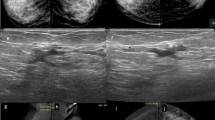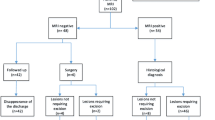Abstract
Objectives
Comparing the sensitivity of Contrast-Enhanced Magnetic Resonance Imaging (CEMRI), mammography and ultrasonography in patients with nipple discharge (ND).
Methods
We retrospectively evaluated 38 women with ND who underwent mammography, ultrasound and 1.5 T CEMRI between March 2007 and July 2009. Imaging findings, pathological diagnosis and follow-up data (mean follow-up: 20 months) were compared. Sensitivity and specificity values were reckoned. Statistical differences in sensitivity were assessed.
Results
5/38 malignancies (13.2%; 3 invasive, 2 intraductal; 4 ipsilateral, 1 contralateral to ND), and 14/38 High-Risk Lesion (HRL—36.8%; 11 intraductal papillomas, 1 papilloma with LCIS, 1 sclerosing papilloma and 1 atypical intraductal hyperplasia, all ipsilateral) were found. CEMRI identified 5/5 cancers and 13/14 HRL (Overall Sensitivity—OSS = 94.7%; Overall Specificity—OSP = 78.9%). 3/5 cancers (1 invasive, 1 in-situ; 1 invasive contralateral) and 2/14 HRL were detected by CEMRI only. Mammography found 2/5 cancer and 3/14 HRL (OSS = 26.3%; OSP = 94.7%). Ultrasound identified 1/5 cancer and 11/14 HRL (OSS = 63.2%; OSP = 84.2). 1/14 HRL was detected by ultrasound only. Compared with mammography and ultrasound, CEMRI showed statistically significantly higher OSS values (p < 0.0001, p = 0.042 respectively).
Conclusion
In women with ND, CEMRI should be recommended when conventional imaging is negative. Unexplained ND could be considered an indication for CEMRI.







Similar content being viewed by others
References
Hussain AN, Policarpio C, Vincent MT (2006) Evaluating nipple discharge. Obstet Gynecol Surv 61:278–283
Newman HF, Klein M, Northrup JD et al (1983) Nipple discharge: frequency and pathogenesis in an ambulatory population. NY State J Med 83:928–933
Murad TM, Contesso G, Mouriesse H (1982) Nipple discharge from the breast. Ann Surg 195:259–264
Sauter ER, Schlatter L, Lininger J et al (2004) The association of bloody nipple discharge with breast pathology. Surgery 136:780–785
Simmons R, Adamovich T, Brennan M et al (2003) Nonsurgical evaluation of pathologic nipple discharge. Ann Surg Oncol 10:113–116
Falkenberry SS (2002) Nipple discharge. Obstet Gynecol Clin North Am 29:21–29
Kilgore AR, Fleming R, Ramos MM (1953) The incidence of cancer with nipple discharge and the risk of cancer in the presence of papillary disease of the breast. Surg Gynecol Obstet 96:649–660
Morrogh M, Morris EA, Liberman L et al (2007) The predictive value of ductography and magnetic resonance imaging in the management of nipple discharge. Ann Surg Oncol 14:3369–3377
Sickles EA (2000) Galactography and other imaging investigations of nipple discharge. Lancet 356:1622–1623
Cardenosa G, Eklund GW (1991) Benign papillary neoplasms of the breast: mammographic findings. Radiology 181:751–55
Piccoli CW, Feig SA, Vala MA (1998) Benign intraductal papilloma with focal atypical papillomatous hyperplasia. Radiographics 18:783–786
Tabar L, Dean PB, Pentek Z (1983) Galactography: the diagnostic procedure of choice for nipple discharge. Radiology 149:31–38
Orel SG, Dougherty CS, Reynolds C et al (2000) MR imaging in patients with nipple discharge: initial experience. Radiology 216:248–254
Schwab SA, Uder M, Schulz-Wendtland R et al (2008) Direct MR galactography: feasibility study. Radiology 249:54–61
Hirose M, Nobusawa H, Gokan T (2007) MR ductography: comparison with conventional ductography as a diagnostic method in patients with nipple discharge. Radiographics 27:S183–S196
Kuhl CK (2007) The current status of breast MR imaging. Part I. Choice of technique, image interpretation, diagnostic accuracy, and transfer to clinical practice. Radiology 244:356–378
Kuhl CK (2007) Current status of breast MR imaging. Part II. Clinical applications. Radiology 244:672–691
Kuhl CK, Schrading S, Bieling HB et al (2007) MRI for diagnosis of pure ductal carcinoma in situ: a prospective observational study. Lancet 370:485–492
Linda A, Zuiani C, Londero V et al (2008) Outcome of initially only magnetic resonance mammography-detected findings with and without correlate at second-look sonography: distribution according to patient history of breast cancer and lesion size. Breast 17:53–59
Bazzocchi M, Zuiani C, Bendini M et al (1994) US-guided breast biopsy with an automated cutting needle. Eur Radiol 4:360–363
ACR breast imaging reporting and data system (2003) Breast imaging atlas. American College of Radiology, Reston
D’Orsi CJ, Bassett WA, Berg WA et al (2003) Breast Imaging Reporting and Data System, BI-RADS: mammography. American College of Radiology, Reston
Mendelson EB, Baum JK, Berg WA et al (2003) Breast Imaging Reporting and Data System, BI-RADS: ultrasound. American College of Radiology, Reston
Morris EA, Harms S (2004) ACR practice guideline for the performance of magnetic resonance imaging (MRI) of the breast. American College of Radiology, Reston
NHSB (1994) Guidelines for cytology procedures and reporting on fine needle aspirates of the breast. Cytology Subgroup of the National Coordinating Committee for Breast Cancer Screening Pathology. Cytopathology 4:316–334
NHSBSP (2001) Non-operative Diagnosis Subgroup of the National Coordinating Group for Breast Screening Pathology. Publication No 50
Perry N, Broeders M, de Wolf C et al (2008) European guidelines for quality assurance in breast cancer screening and diagnosis. Fourth edition—summary document. Ann Oncol 19:614–622
Kramer SC, Rieber A, Görich J et al (2000) Diagnosis of papillomas of the breast: value of magnetic resonance mammography in comparison with galactography. Eur Radiol 10:1733–1736
Daniel BL, Gardner RW, Birdwell RL et al (2003) Magnetic resonance imaging of intraductal papilloma of the breast. Magn Reson Imaging 21:887–892
LaTrenta LR, Menell JH, Morris EA et al (2003) Breast lesions detected with MR imaging: utility and histopathologic importance of identification with US. Radiology 227:856–861
Author information
Authors and Affiliations
Corresponding author
Rights and permissions
About this article
Cite this article
Lorenzon, M., Zuiani, C., Linda, A. et al. Magnetic resonance imaging in patients with nipple discharge: should we recommend it?. Eur Radiol 21, 899–907 (2011). https://doi.org/10.1007/s00330-010-2009-y
Received:
Revised:
Accepted:
Published:
Issue Date:
DOI: https://doi.org/10.1007/s00330-010-2009-y




